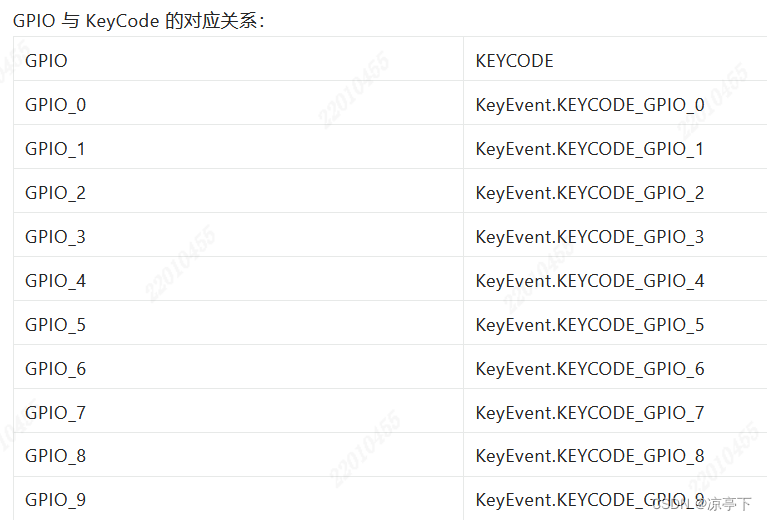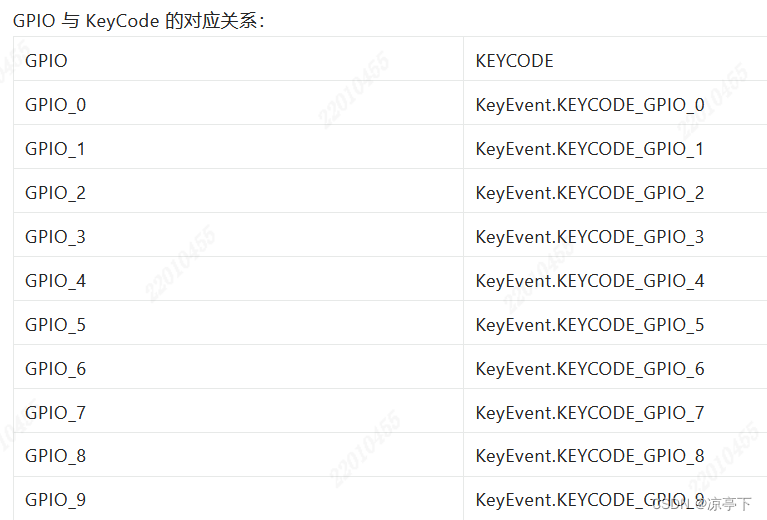
【干货】Android系统定制基础篇:第十五部分(Android支持鼠标右键返回、GPIO 控制方案、属性标识USB摄像头的VID与PID)
GPIO 功能在 Android Framework 中增加 GPIO 相关 API,让 APP 可以直接通过 JAVA API 操控 GPIO。支持 输入、输出、模拟按键 三种模式。做为输入时可以用于app获取外部设备的电平状态。做为输出时可以输出高低电平,用于控制外设。当做为模拟按键时,此 GPIO 低电平时 APP 会收到对应的键值。参考项目,移植驱动和 Framework 代码。完整 DE
1、修改 frameworks/native/services/inputflinger/InputReader.cpp 如下:
diff --git a/frameworks/native/services/inputflinger/InputReader.cpp b/frameworks/native/services/inputflinger/Inp
index 7207a83..2721800 100755
--- a/frameworks/native/services/inputflinger/InputReader.cpp
+++ b/frameworks/native/services/inputflinger/InputReader.cpp
@@ -1422,6 +1422,7 @@ uint32_t CursorButtonAccumulator::getButtonState() const {
result |= AMOTION_EVENT_BUTTON_PRIMARY;
}
if (mBtnRight) {
+ /*
char targetProduct[PROPERTY_VALUE_MAX] = {0};
property_get("ro.target.product", targetProduct, "");
if (strcmp(targetProduct, "box") == 0) {
@@ -1429,6 +1430,9 @@ uint32_t CursorButtonAccumulator::getButtonState() const {
} else {
result |= AMOTION_EVENT_BUTTON_SECONDARY;
}
+ */
+
+ result |= AMOTION_EVENT_BUTTON_BACK;
}
if (mBtnMiddle) {
result |= AMOTION_EVENT_BUTTON_TERTIARY;
二、Android GPIO 控制方案
GPIO 功能在 Android Framework 中增加 GPIO 相关 API,让 APP 可以直接通过 JAVA API 操控 GPIO。支持 输入、输出、模拟按键 三种模式。做为输入时可以用于app获取外部设备的电平状态。做为输出时可以输出高低电平,用于控制外设。当做为模拟按键时,此 GPIO 低电平时 APP 会收到对应的键值。
移植
参考项目 Android-GPIOControlDriver,移植驱动和 Framework 代码。
使用
1.在 APP 源码 aidl/android/os/ 目录下新建 IGpioService.aidl,如下:
package android.os;
/** {@hide} */
interface IGpioService
{
int gpioWrite(int gpio, int value);
int gpioRead(int gpio);
int gpioDirection(int gpio, int direction, int value);
int gpioRegKeyEvent(int gpio);
int gpioUnregKeyEvent(int gpio);
int gpioGetNumber();
}
2.参考下面源码调用 GPIO 相关 API:
package com.ayst.sample.items.gpio;
import android.annotation.SuppressLint;
import android.content.Context;
import android.os.IBinder;
import android.os.IGpioService;
import android.os.RemoteException;
import java.lang.reflect.Method;
/**
* Created by Administrator on 2018/11/6.
*/
public class Gpio {
private IGpioService mGpioService;
@SuppressLint("WrongConstant")
public Gpio(Context context) {
Method method = null;
try {
method = Class.forName("android.os.ServiceManager").getMethod("getService", String.class);
IBinder binder = (IBinder) method.invoke(null, new Object[]{"gpio"});
mGpioService = IGpioService.Stub.asInterface(binder);
} catch (Exception e) {
e.printStackTrace();
}
}
/**
* GPIO write
*
* @param gpio 0~Number
* @param value 0: Low 1: High
*/
public void gpioWrite(int gpio, int value) {
if (null != mGpioService) {
try {
mGpioService.gpioWrite(gpio, value);
} catch (RemoteException e) {
e.printStackTrace();
}
}
}
/**
* GPIO read
*
* @param gpio 0~Number
* @return 0: Low 1: High other:error
*/
public int gpioRead(int gpio) {
if (null != mGpioService) {
try {
return mGpioService.gpioRead(gpio);
} catch (RemoteException e) {
e.printStackTrace();
}
}
return -1;
}
/**
* GPIO direction
*
* @param gpio 0~Number
* @param direction 0: input 1: output
* @param value 0: Low 1: High
*/
public void gpioDirection(int gpio, int direction, int value) {
if (null != mGpioService) {
try {
mGpioService.gpioDirection(gpio, direction, value);
} catch (RemoteException e) {
e.printStackTrace();
}
}
}
/**
* GPIO register key event
*
* @param gpio 0~Number
*/
public void gpioRegKeyEvent(int gpio) {
if (null != mGpioService) {
try {
mGpioService.gpioRegKeyEvent(gpio);
} catch (RemoteException e) {
e.printStackTrace();
}
}
}
/**
* GPIO unregister key event
*
* @param gpio 0~Number
*/
public void gpioUnregKeyEvent(int gpio) {
if (null != mGpioService) {
try {
mGpioService.gpioUnregKeyEvent(gpio);
} catch (RemoteException e) {
e.printStackTrace();
}
}
}
/**
* Get GPIO number
*
* @return <0: error other: GPIO number
*/
public int gpioGetNumber() {
if (null != mGpioService) {
try {
return mGpioService.gpioGetNumber();
} catch (RemoteException e) {
e.printStackTrace();
}
}
return -1;
}
}
输入
// 将GPIO_0设置为输入
gpio.gpioDirection(0, 0, 0);
// 读GPIO_0电平
int level = gpio.gpioRead(0);
输出
// 将GPIO_0设置为输出,并默认输出低电平
gpio.gpioDirection(0, 1, 0);
// GPIO_0输出高电平
gpio.gpioWrite(0, 1);
按键模式
/* 将GPIO_0设置按键模式
当GPIO_0为低电平时将收到KeyEvent.KEYCODE_GPIO_0 KeyEvent.ACTION_DOWN,
当GPIO_0为高电平时收到KeyEvent.KEYCODE_GPIO_0 KeyEvent.ACTION_UP
*/
gpio.gpioRegKeyEvent(0);
 完整 DEMO 源码请参考:https://github.com/aystshen/topband_sample
完整 DEMO 源码请参考:https://github.com/aystshen/topband_sample
三、属性标识USB摄像头的VID与PID
Android 在使用多个 USB 摄像头时,根据加载顺序不同他们的设备文件顺序不同,比如:“video0, video1, video2”,每次启动它们的顺序都可能不同,这样 APP 就无法知道哪个设备文件对应的是哪个摄像头,因此下面方案增加属性来标识设备文件与摄像头 VID、PID 的关系,这样就解决了上面的问题。
实现
diff --git a/frameworks/base/services/usb/java/com/android/server/usb/UsbDeviceManager.java b/frameworks/base/services/usb/java/com/android/server/usb/UsbDeviceManager.java
index 26d5ac9..cfd8479 100755
--- a/frameworks/base/services/usb/java/com/android/server/usb/UsbDeviceManager.java
+++ b/frameworks/base/services/usb/java/com/android/server/usb/UsbDeviceManager.java
@@ -51,6 +51,7 @@ import android.os.UserManager;
import android.os.storage.StorageManager;
import android.os.storage.StorageVolume;
import android.provider.Settings;
+import android.text.TextUtils;
import android.util.Pair;
import android.util.Slog;
@@ -61,8 +62,10 @@ import com.android.internal.os.SomeArgs;
import com.android.internal.util.IndentingPrintWriter;
import com.android.server.FgThread;
+import java.io.BufferedReader;
import java.io.File;
import java.io.FileNotFoundException;
+import java.io.FileReader;
import java.io.IOException;
import java.util.HashMap;
import java.util.HashSet;
@@ -95,6 +98,10 @@ public class UsbDeviceManager {
* The non-persistent property which stores the current USB actual state.
*/
private static final String USB_STATE_PROPERTY = "sys.usb.state";
+
+ private static final String USB_CAMERA_PROPERTY_PRE = "topband.dev.";
+
+ private static final String USB_CAMERA_CLASS_PATH = "/sys/class/video4linux";
/**
* ro.bootmode value when phone boots into usual Android.
@@ -215,15 +222,29 @@ public class UsbDeviceManager {
if (devPath != null && devPath.contains("/devices/platform")) {
if ("video4linux".equals(subSystem)) {
Intent intent = new Intent(Intent.ACTION_USB_CAMERA);
+
String action = event.get("ACTION");
+ String name = event.get("DEVNAME");
+ String idProduct = searchAndReadFileBackward("/sys" + devPath, "idProduct");
+ String idVendor = searchAndReadFileBackward("/sys" + devPath, "idVendor");
+
+ if (DEBUG) Slog.d(TAG, action + " usb camera: " + name + " [" + idVendor + ":" + idProduct + "]");
if ("remove".equals(action)){
Slog.d(TAG,"usb camera removed");
intent.setFlags(Intent.FLAG_USB_CAMERA_REMOVE);
SystemProperties.set("persist.sys.usbcamera.status","remove");
+
+ if (!name.isEmpty()) {
+ SystemProperties.set(USB_CAMERA_PROPERTY_PRE + name, "");
+ }
} else if ("add".equals(action)) {
Slog.d(TAG,"usb camera added");
intent.setFlags(Intent.FLAG_USB_CAMERA_ADD);
SystemProperties.set("persist.sys.usbcamera.status","add");
+
+ if (!name.isEmpty() && !idProduct.isEmpty() && !idVendor.isEmpty()) {
+ SystemProperties.set(USB_CAMERA_PROPERTY_PRE + name, idVendor + ":" + idProduct);
+ }
}
int num = android.hardware.Camera.getNumberOfCameras();
@@ -243,6 +264,99 @@ public class UsbDeviceManager {
}
}
};
+
+ private void initUsbCameraProperty() {
+ File filePath = new File(USB_CAMERA_CLASS_PATH);
+ File[] files = filePath.listFiles();
+ if (null != files) {
+ for (File file : files) {
+ if (file.isDirectory()) {
+ String idProduct = searchAndReadFileForward(file.getPath() + "/device/input", "product");
+ String idVendor = searchAndReadFileForward(file.getPath() + "/device/input", "vendor");
+ if (!TextUtils.isEmpty(idProduct) || !idVendor.isEmpty()) {
+ if (DEBUG) Slog.v(TAG, "initUsbCameraProperty, add camera property: " + idVendor + ":" + idProduct);
+ SystemProperties.set(USB_CAMERA_PROPERTY_PRE + file.getName(), idVendor + ":" + idProduct);
+ }
+ }
+ }
+ }
+ }
+
+ private String searchAndReadFileForward(String filePath, String fileName) {
+ if (TextUtils.isEmpty(filePath) || TextUtils.isEmpty(fileName)) {
+ return "";
+ }
+
+ return searchAndReadFileForward(new File(filePath), fileName);
+ }
+
+ private String searchAndReadFileForward(File filePath, String fileName) {
+ if (null != filePath && !TextUtils.isEmpty(fileName)) {
+ Slog.v(TAG, "searchAndReadFileForward, path: " + filePath.getPath());
+
+ File file = new File(filePath.getPath() + "/" + fileName);
+ if (file.exists()) {
+ return readFileByLines(file.getPath());
+ }
+
+ File[] files = filePath.listFiles();
+ if (null != files) {
+ for (File subfile : files) {
+ if (subfile.isDirectory()) {
+ return searchAndReadFileForward(subfile, fileName);
+ }
+ }
+ }
+ }
+
+ return "";
+ }
+
+ private String searchAndReadFileBackward(String filePath, String fileName) {
+ if (TextUtils.isEmpty(filePath) || TextUtils.isEmpty(fileName)) {
+ return "";
+ }
+
+ return searchAndReadFileBackward(new File(filePath), fileName);
+ }
+
+ private String searchAndReadFileBackward(File filePath, String fileName) {
+ if (null != filePath && !TextUtils.isEmpty(fileName)) {
+ File file = new File(filePath.getPath() + "/" + fileName);
+ if (file.exists()) {
+ return readFileByLines(file.getPath());
+ }
+
+ searchAndReadFileBackward(filePath.getParentFile(), fileName);
+ }
+
+ return "";
+ }
+
+ private static String readFileByLines(String fileName) {
+ File file = new File(fileName);
+ BufferedReader reader = null;
+ StringBuilder builder = new StringBuilder();
+ try {
+ reader = new BufferedReader(new FileReader(file));
+ String tempString;
+ while ((tempString = reader.readLine()) != null) {
+ builder.append(tempString);
+ }
+ reader.close();
+ return builder.toString();
+ } catch (IOException e) {
+ Slog.e(TAG, "readFileByLines, " + e.getMessage());
+ } finally {
+ if (reader != null) {
+ try {
+ reader.close();
+ } catch (IOException ignored) {
+ }
+ }
+ }
+ return "";
+ }
public UsbDeviceManager(Context context, UsbAlsaManager alsaManager,
UsbSettingsManager settingsManager) {
@@ -494,7 +608,7 @@ public class UsbDeviceManager {
UsbManager.removeFunction(UsbManager.removeFunction(persisted,
UsbManager.USB_FUNCTION_MTP), UsbManager.USB_FUNCTION_PTP));
}
}
String state = FileUtils.readTextFile(new File(STATE_PATH), 0, null).trim();
updateState(state);
@@ -548,7 +662,7 @@ public class UsbDeviceManager {
} else if ("CONFIGURED".equals(state)) {
connected = 1;
configured = 1;
if ("true".equals(SystemProperties.get("ro.usb.default_mtp")) &&
UsbManager.containsFunction(mCurrentFunctions, UsbManager.USB_FUNCTION_MTP))
mUsbDataUnlocked = true;
} else {
@@ -1030,6 +1144,7 @@ public class UsbDeviceManager {
updateUsbNotification(false);
updateAdbNotification(false);
updateUsbFunctions();
+ initUsbCameraProperty();
break;
case MSG_LOCALE_CHANGED:
updateAdbNotification(true);
验证
编译运行后,读取属性如下:
[topband.dev.video0]: [0bda:2714]
[topband.dev.video1]: [0bda:b321]
更多推荐
 已为社区贡献10条内容
已为社区贡献10条内容










所有评论(0)